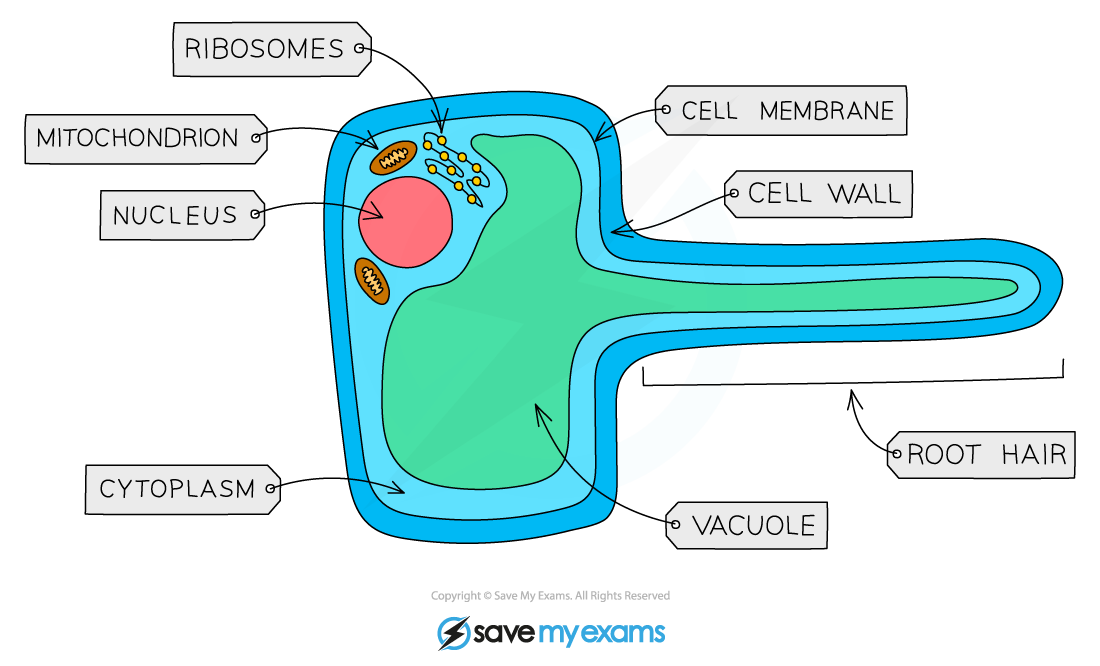Level of organisation and Cell structure
1/4
Earn XP
Description and Tags
Name | Mastery | Learn | Test | Matching | Spaced |
|---|
No study sessions yet.
5 Terms
What are the levels of organisation in organisms?

What are the cell structures and their functions in both plants and animals?
CELL STRUCTURE | DESCRIPTION |
NUCLEUS | Membrane-bound organelle that contains genetic material |
CYTOPLASM | Material that fills cell to facilitate chemical reactions and hold organelles in place |
CELL MEMBRANE | Phospholipid bilayer that controls the movement of substances into and out of cell |
CELL WALL | External to cell membrane that protects and maintains the shape of cell (prevents cell from bursting) |
MITOCHONDRIA | Membrane-bound organelle that carries out cellular respiration |
CHLOROPLAST | Plastids in plants that carry out photosynthesis |
RIBOSOME | Site of protein synthesis |
VACUOLE | Storage organelle in plants to store Water and dissolved substances |
What are the similarities and differences between plant and animal cells?
PLANT CELL | ANIMAL CELL |
Multicellular organism | |
Nucleus | |
Mitochondria | |
Cytoplasm | |
Cell membrane | |
Ribosomes | |
Fixed shape | No fixed shape |
Large vacuole | Little or no vacuole |
Cell wall | No cell wall |
Stores carbohydrates as Starch | Stores carbohydrates as Glycogen |
Contains Chloroplasts to conduct photosynthesis | Does not contain Chloroplasts (cannot conduct photosynthesis) |
What is the importance of cell differentiation in the development of specialised cells?
Cell Differentiation & Specialised Cells
The structural differences between different types of cells enable them to perform specific functions within the organism
Cell differentiation is an important process by which a cell changes to become specialised
Cell differentiation is how cells develop the structure and characteristics needed to be able to carry out their functions
Specialised cells are those that have developed certain characteristics that allow them to perform particular functions. These differences are controlled by genes in the nucleus
As an organism develops, cells differentiate to form different types of cells
When a cell differentiates, it develops a structure and composition of subcellular structures which enables it to carry out a certain function
E.g. to form a nerve cell the cytoplasm and cell membrane of an undifferentiated cell must elongate to form connections over large distances

Diagram showing the possible differentiation of a human cell into two different cell types
Differentiation and development
As a multicellular organism develops, its cells differentiate to form specialised cells
In an animal, most cells differentiate at an early stage of development
As a result, animal cells lose their ability to differentiate early in the life of the organism
Specific cells in various locations throughout the body of an animal retain the ability to differentiate throughout the life of the animal
These undifferentiated cells are called adult stem cells and they are mainly involved in replacing and repairing cells (such as blood or skin cells)
Plants differ from animals in that many types of plant cells retain the ability to fully differentiate throughout the life of a plant, not just in the early stages of development
Examples of specialised cellsCiliated cell
Ciliated cells move mucus in the trachea and bronchi
They have hair-like extensions called cilia, which beat to transport mucus and trapped particles toward the throat

Ciliated epithelial cells
Nerve cell
Nerve cells conduct impulses and are long, allowing communication between different parts of the body and the central nervous system
Their axons are covered in a fatty sheath that insulates and speeds up nerve transmission

A nerve cell
Red blood cell
Red blood cells transport oxygen efficiently due to their biconcave shape, increasing surface area for oxygen diffusion
They contain haemoglobin and lack a nucleus, maximizing space for oxygen transport

Red blood cells
Root hair cell
Root hair cells absorb water and mineral ions from the soil
Their long extensions increase surface area for maximum absorption, and their thin walls help water move quickly through them

Root hair cell
Palisade mesophyll cell
Palisade mesophyll cells perform photosynthesis and are column-shaped to maximize light absorption
They contain numerous chloroplasts and are tightly packed beneath the upper epidermis of the leaf to optimize photosynthesis

Palisade mesophyll cell
What are the advantages and disadvantages of using stem cells in medicine?
 STEM CELLS: Unspecialised cells that has two key qualities:
STEM CELLS: Unspecialised cells that has two key qualities:
Self-renewal: capable of continuous division and replication
Potency: capacity to differentiate into specialised cell type
STEM CELLS IN MEDICINE |
Picture showing the use of Stem Cell Therapy to form Tissue |
EXPLANATION:
|
ADVANTAGES AND DISADVANTAGES:
ADVANTAGE | DISADVANTAGE |
Medical benefits in therapeutic cloning to heal diseases and chronic illnesses | Ethical issues surrounding the use of embryonic stem cells involving the destruction of human embryos |
Potential in discovering treatments and cures for diseases such as Parkinson's disease and cancer | Uncertainties regarding long-term effects |
Ability to test potential drugs and medicine without the use of animals or human simulation | Rejection by the patient's body as certain stem cells are obtained from embryos instead of their own cells |
Reduced risk of rejection as patient's own cells can be used | Difficulty in controlling differentiation of pre-specialised cells into desired cell |
